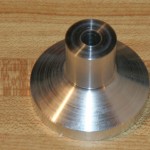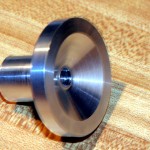I Lied
June 26th, 2009Machining has Occurred
Here it is! I made a knob for the toilet on my dad’s boat!
Feast your eyes on that. It took me three hours. I started with a 2″ aluminum cylinder, and I ended up with a knob that is probably 1 7/8″ in diameter, and I drilled a hole down the middle using my tailstock.
The finish is really nice. I’m surprised. I did it with the HSS tool I made, and it came out fine.
Let’s see. I used that tool to rough it out. I created the basic shape of the stem and the slope on the stem side of the disk. Then I used the compound slide to clean up that side. I cleaned up the circumference of the disk and faced the end. Then I used the compound slide to make a slope on the face, parallel to the slope on the stem side. I used a carbide tool to clean up the stem, and then I polished the stem with the HSS tool. I used a file to break the hard edges. After that, I put a big drill bit in my Albrecht chuck, stuck it in the tailstock, and made a hole for the shaft.
I don’t really know what I’m doing, so I relied on a round-nose tool, which is like the Wonkavator of lathe tools. It sort of does everything.
I made the knob long so it would be easier to reach. I still haven’t made a setscrew hole. I guess I’ll have to do that with a hand drill.
It’s driving me crazy. It’s beautiful, but it’s already picking up scratches and dings. I’ll feel better when it’s on the toilet.
I’d like to turn it into a cross, so it would be easier to grip. No mill, though. It would be very hard to do on a lathe. I guess I could have knurled it. Maybe I still can. I don’t want to mar it up in a chuck, but I could put it on a bolt and chuck the bolt.
I can tell I’m going to love machining. I can’t believe I made this thing. There are a few tool hurdles most men never clear. Welding is one. Routing is another. Machining is pretty much the final frontier. If you can do these things, you can do just about whatever you need to do. You can find weirder things to do, like casting and forging, but unless you’re a pathological nerd you’ll never need that stuff.
Drilling with the lathe is wonderful. The control is amazing. Don’t waste a second wondering how to keep the bit where you want it. It has no choice. It’s too bad you can only drill into the center of the work, unless you want to spend a year playing with clamps and a backplate to get the hole where you want it.
Man, I wish the mill was here. The DRO would make finishing this so simple.


June 26th, 2009 at 9:19 PM
Chucking it on a bolt to knurl it will work. An easier way is to wrap the “tail” in pop or beer can aluminum to protect the finish in the chuck then knurl it. After you knurl it dull the knurl with a wire brush.
Actually, unless you intend to grease the knob to make old folk’s trips to the head even funnier to watch, knurling is overkill.
Gerry N.
June 26th, 2009 at 9:25 PM
I never have aluminum cans in the house. It’s going to be a problem.
.
Overkill is kind of the point. When you do this stuff for a hobby, you look for ways to make it more complicated.
June 27th, 2009 at 3:51 AM
You should make two, just in case.
Cheers
June 27th, 2009 at 7:38 AM
Man, that looks nice.
June 28th, 2009 at 9:45 PM
Good Job!
.
What type of Aluminum? I’m guessing 6061? If so, you may want to clear-coat it to avoid the creeping gray finish…especially in marine environments.
June 29th, 2009 at 12:22 PM
For your next trick, try anodizing. You will need:
1) A PVC-coated apron;
2) A transparent face shield;
3) Both caustic and acid drain cleaners;
4) A couple of GLASS (this is important) containers deep enough to completely sink the object to be anodized;
5) A source of 12 to 24V DC;
6) Something to use for a cathode — lead is good, carbon rods salvaged from old dry cell batteries are better;
7) Clothes dyes in the colors you want;
8) Tongs made of plastic or wood.
Read the labels on the drain cleaners. Drano is caustic (sodium hydroxide), many others are acid (sulfuric). You can also use battery acid, often available from auto parts or hardware stores.
For the caustic solution, mix two tablespoonfuls of Drano per quart of water. For the acid solution, add two ounces of sulfuric acid to each quart. If you can get chromic acid, add half an ounce of that; it makes a nicer result. If not, no big worries.
The caustic solution is a cleaner. Dip the part in and swish it around a bit.
Connect the positive (cathode) lead to the inert cathode and the negative (anode) lead to the part, and drop both into the acid solution. Wait a bit. The part will develop a sort of fuzzy white coating. When you think it’s thick enough — a little experimentation is good; it depends on the current you can get and the strength of the acid solution — pull it out and wash it in clear water.
If you want color, mix the whole packet of clothes dye in as little water as will dissolve it. Dunk the part and leave it there for a while.
Once the color is on, put it in water on the stove and boil it for half an hour or so. Done!
Note that you haven’t used anything your neighbors haven’t flushed down the sewer when trying to clean out their drains. Just dilute the solutions ten to one or better and pour them out.
Regards,
Ric